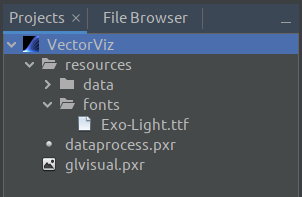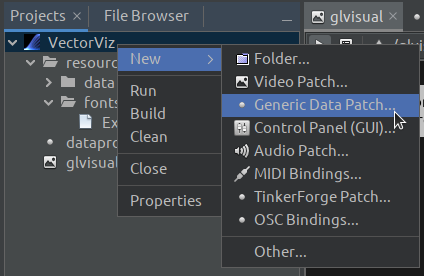Projects
The PraxisCORE architecture is driven by its own simple scripting language - Praxis Command Language (Pcl). However, using PraxisLIVE you don't need to know this as the project system allows you to build projects graphically.
PraxisLIVE projects are folders. The configuration of each root in your
project (video patch, audio patch, control panel, etc.) is stored in a separate file.
These files have the .pxr file extension.
The scripts and other elements that make up a PraxisLIVE project are divided into Build Level elements and Run Level elements. It is important to remember that everything is edited live, so only components that are actually installed in the hub can be edited. For this reason, you can build a project to enable editing without needing to run it. As you develop a project, the system tracks which elements have and haven't been executed, so that you can always build and/or run a project at any time.
The main project folder also contains a resources folder. It is recommended that
you store all media required by your project in the resources folder, or a sub-folder
of it. This allows for projects to be completely self contained and makes distributing
them easier. The pop-up menu on resource folders provides the ability to import files or
open in the system file browser.
All files that define a project are Pcl scripts, allowing for projects to also be run using the command line player or standalone harness. When running from the command line or standalone there is no distinction between build level and run level files.
Project tab
The Projects tab gives you the tools for creating, opening and managing projects. Projects
are shown in a file view which shows you all the user-editable files.

Here you can see one of the example projects opened within the projects tab, with
all folders expanded. Note the location of .pxr files which define different roots,
as well as various resource files.
To run a project, select it and use the buttons on the toolbar, or use the pop-up menu on the main project folder.
To stop and clean a running project, also use the toolbar button or pop-up menu. You will be given the option to save any changes.
The .pxr files will open for editing automatically when a project is built or run. You
can also open these files manually.
You can create a new .pxr file, such as an audio or video patch, from the project's pop-up menu.
Selecting one of these options will open a wizard which will allow you to provide the root ID, which
will also be used as the name of the file. If the project isn't built, you will be given the option
to build it so that the file can be edited.

The Properties option in the project's pop-up menu will open the project configuration
dialog. You can use this to control the Build and Run elements of the project, as well
as configure libraries, hub configuration and Java settings.
Hub configuration
Inside the project properties you will find support for configuring the hub, including control of which roots run in local external processes or on a remote machine. The same settings will apply when running the project within the IDE, and when running from the command line or standalone.
The hub configuration is currently edited as text, as a nested map. It can only be edited when the project isn't active, otherwise the text area will be read only. Clean the project if necessary to edit. A full UI for hub configuration will be in a future IDE update.
The typical default project configuration will run audio and video roots in separate local processes.
enable-fileserver false
proxies {
video {
host localhost
port auto
id-pattern *
type-pattern video
exec {
command default
java-options {
-XstartOnFirstThread
-XX:+IgnoreUnrecognizedVMOptions
-Djava.awt.headless=true
}
}
}
audio {
host localhost
port auto
id-pattern *
type-pattern audio
exec {
command default
}
}
}
Proxies must have unique names (eg. video, audio) although these are only used for informational
purposes. The id and type fields use glob patterns, including * and | to match against root
id and type, checked in the order they're specified. Host and port can be local or remote - a port
setting of auto can be only used where a child process is being launched.
An exec section, if specified, will auto-launch another process when required (unlike earlier
versions of PraxisLIVE, the child process support in PraxisCORE is lazy). A command of
default means to create a new version of the existing process, with specified java-options.
Other commands and argument passing will be supported in a future update.
The file server can be enabled if using remote processes to serve resources to them. Note that there is no authentication involved, so be careful with network security.
You can launch a PraxisCORE process on another machine and connect to it over the network from the IDE. To launch the child use the command line launcher -
praxis --network all --port 42424
See the command line launcher documentation for more information.
Assuming the above process is running on a machine at 192.168.0.42 the IDE set the project
configuration to this and build the project as normal -
enable-fileserver true
proxies {
all {
host 192.168.0.42
port 42424
id-pattern *
type-pattern *
}
}